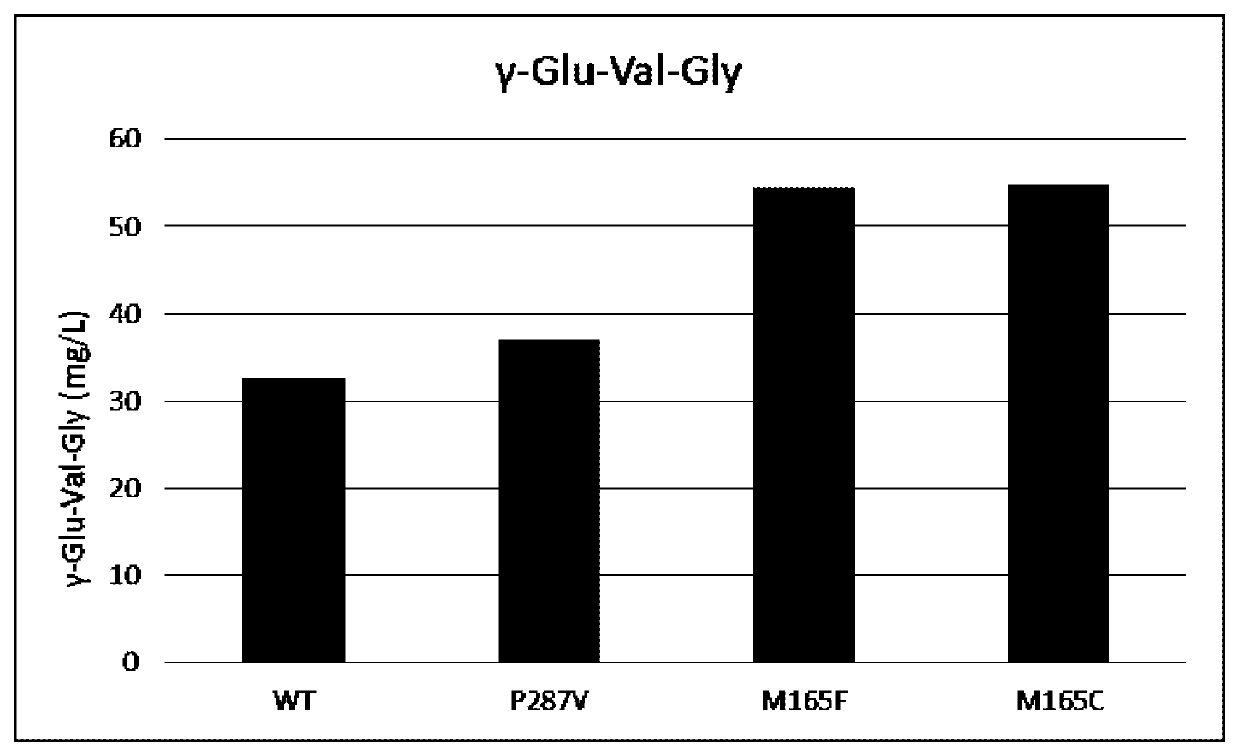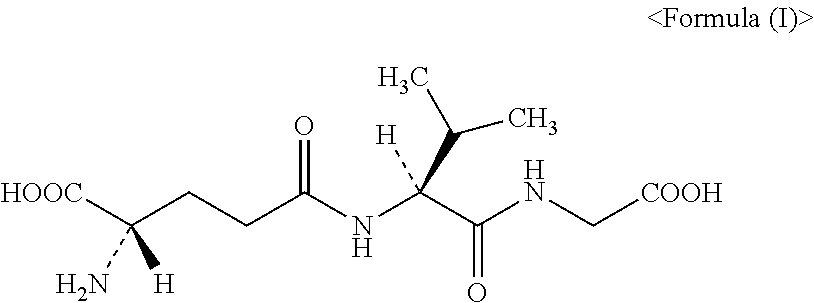Mutant glutathione synthetase and method for producing gamma-glutamyl-valyl-glycine
a technology of gamma-glutamyl valyl and glutathione, which is applied in the field of mutant glutathione synthetase and a method for producing gamma-glutamyl valyl, to achieve the effect of reducing the activity of -glutamyltransferas
- Summary
- Abstract
- Description
- Claims
- Application Information
AI Technical Summary
Benefits of technology
Problems solved by technology
Method used
Image
Examples
example 1
[Example 1] Construction of Expression Plasmid for Wild-Type gshB Gene
[0251]Escherichia coli BL21(DE3) (Life Technologies) was transformed with pET-gshB (Japanese Patent Laid-open (Kokai) No. 2012-85637), which is an expression plasmid for the gshB gene (SEQ ID NO: 1) of Escherichia coli W3110 (ATCC 27325) encoding glutathione synthetase, to obtain Escherichia coli BL21(DE3) / pET-gshB. The nucleotide sequence of the gshB gene and the amino acid sequence of the GSHB encoded by that gene are shown as SEQ ID NOS: 1 and 2, respectively. With pET-gshB, the GSHB is expressed with a His tag added to the C-terminus.
example 2
[Example 2] Construction of Expression Plasmids for Mutant gshB Genes
[0252]In order to construct mutant gshB genes, PCR was performed by using the primers corresponding to the respective mutant gshB genes (SEQ ID NOS: 3 to 18) and pET-gshB described in Example 1 as the template with Quik Change Site-Directed Mutagenesis Kit (Stratagene) according to the protocol of the manufacturer. The relations between the mutations and the primers are shown in Table 1. In the table, the sequences indicated with capital letters correspond to the amino acid residues for which a mutation was introduced.
[0253]Each of the obtained PCR products was digested with DpnI, and Escherichia coli JM109 was transformed with the digestion reaction mixture, applied to the LB agar medium containing 100 μg / mL of ampicillin sodium salt (Amp), and cultured at 30° C. for 20 hours. Plasmids were extracted from the colonies of the grown transformants by a known method, the nucleotide sequences thereof were confirmed by ...
example 4
[Example 4] Generation of γ-Glu-Val-Gly Using Each Purified GSHB
[0257]The synthesis activity of γ-Glu-Val-Gly (CAS 38837-70-6; also referred to as “Gluvalicine”) was measured for each of the purified GSHBs obtained in Example 3.
[0258]The measurement conditions for the γ-Glu-Val-Gly synthesis activity were as follows. The composition of the reaction mixture consisted of 10 mM γ-Glu-Val, 150 mM glycine, 10 mM ATP, and 10 mM MgSO4 in 100 mM Tris-HCl (pH 9.0). The volume of the reaction mixture was 0.2 mL, and the enzymatic reaction was started by adding the purified enzyme. The purified GSHB was added to reaction mixture at a concentration of 0.025 mg / rnL. The reaction temperature was 30° C., and the reaction time was 30 minutes. For terminating the reaction, 0.2 mL of 200 mM sulfuric acid was added per 0.2 mL of the reaction mixture. After completion of the reaction, the generated γ-Glu-Val-Gly was quantified by HPLC.
[0259]The quantification conditions for γ-Glu-Val-Gly were as follow...
PUM
| Property | Measurement | Unit |
|---|---|---|
| temperature | aaaaa | aaaaa |
| pH | aaaaa | aaaaa |
| temperature | aaaaa | aaaaa |
Abstract
Description
Claims
Application Information
 Login to View More
Login to View More - R&D
- Intellectual Property
- Life Sciences
- Materials
- Tech Scout
- Unparalleled Data Quality
- Higher Quality Content
- 60% Fewer Hallucinations
Browse by: Latest US Patents, China's latest patents, Technical Efficacy Thesaurus, Application Domain, Technology Topic, Popular Technical Reports.
© 2025 PatSnap. All rights reserved.Legal|Privacy policy|Modern Slavery Act Transparency Statement|Sitemap|About US| Contact US: help@patsnap.com


